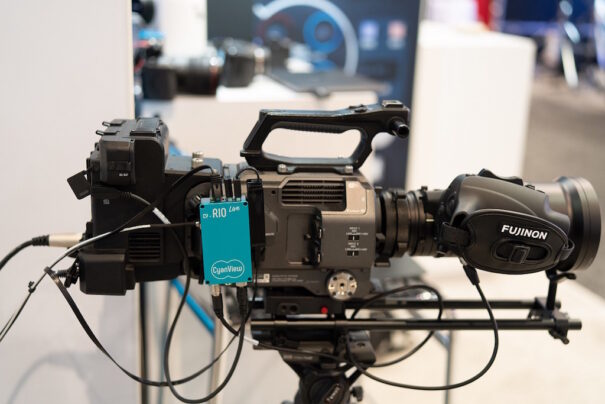CyanView llevará a IBC su control remoto RIO Live, un complemento para cámaras que facilita el sombreado
Con motivo de IBC 2022, CyanView exhibirá su nueva solución RIO Live, un complemento montado en la cámara que facilita el sombreado y el tally a través de una diversa gama de cámaras D-Cinema, videocámaras y cámaras sin espejo en producciones en directo multicámara.
La unidad RIO Live, que ya se exhibió por vez primera en NAB 2022, puede coordinarse con una amplia gama de cámaras para facilitar el control remoto. La amplia gama de cámaras que admite y las flexibles opciones de conexión disponibles proporcionan a los productores y creativos, tanto en el mercado broadcast como en el proAV, la capacidad de desplegar complejas configuraciones de cámara.
Esto es fundamental cuando se utilizan cámaras D-Cinema de gran sensor con objetivos zoom PL y LUTs 3D, y garantiza que se pueda asegurar un aspecto específico y consistente (lo que normalmente se consigue en la postproducción) en todas las cámaras, incluso en producciones en directo y durante el streaming.
La unidad RIO Live permite además controlar objetivos zoom y motores de objetivos, incluidos los objetivos de caja B4, los objetivos zoom PL, los Cine Servos of Canon and the Cabrios of Fujinon, junto con el C-Motion en objetivos zoom grandes, y los motores Chrosziel y Tilta en objetivos principales. También facilita el control total del gimbal, lo que permite a los productores crear una configuración PTZ utilizando las cámaras y los accesorios de su elección, incluyendo cámaras robóticas y de cable, dollies y jibs.
Por último, la unidad también permite controlar el tally interno de una cámara o un tally auxiliar conectado a la propia RIO Live, con la selección de la cámara y la ingesta del tally realizadas a través de protocolos como TSL y GPIO, o integraciones directas con Atem, Tricaster o Vmix.
Además de proporcionar control físico sobre todas las cámaras, incluido el inicio simultáneo de las grabaciones, RIO Live facilita la funcionalidad completa de sombreado en una configuración multicámara. Esto incluye el control remoto del sombreado de vídeo para las cámaras en las que dicha funcionalidad podría faltar o estar bloqueada, o cuando se utilizan procesadores basados en LUT 3D as Flanders Box-IO, AJA ColorBox o CyanView VP4 para añadir y coordinar funcionalidades según sea necesario.
Lo más importante es que todo esto se puede coordinar de forma flexible mediante el control remoto de CyanView, ya sea dedicando controladores individuales (o múltiples) a cada cámara, creando subgrupos, o a través de un único controlador maestro.
Esta capacidad de controlar las integraciones de cámaras multimarca a través de un único RCP (o, de hecho, cualquier combinación de RCP que se desee) otorga un inmenso potencial creativo a los profesionales del broadcast, al tiempo que garantiza la coherencia y el orden en toda la configuración.
Pocos otros productos permiten controlar una gama tan diversa de cámaras y estándares a través de un único RCP. En los montajes que combinan los RCP de CyanView y las unidades RIO Live se han visto hasta un centenar de cámaras de varias marcas conectadas a través de un solo control remoto, como los utilizados en los programas de telerrealidad.
De hecho, las capacidades completas del RCP de CyanView también se expondrán en su stand de IBC, demostrando cómo el RCP integra a la perfección el control de la cámara con las correcciones de color lineales disponibles en los correctores RGB y ProcAmp en la postproducción. Su interfaz, que se asemeja a la de una cámara de emisión estándar, permite una eficaz alineación multicámara en las producciones en directo.
CyanView también destacará su compatibilidad con el nuevo AJA ColorBox, una solución de procesamiento de hardware flexible con nodos que garantizan mapeos precisos y una fidelidad de color sin precedentes para flujos de trabajo HDR/SDR en directo y en postproducción.
ColorBox es especialmente útil cuando se implementan múltiples tipos de cámaras y marcas, ya que la alineación de las cámaras en este contexto requiere ajustes más precisos, similares al flujo de trabajo ACES. Con la ColorBox, el proceso se hace tan fácil e intuitivo como si el operador estuviera realizando los ajustes en la propia cámara.
El fundador y director general de CyanView, David Bourgeois, destaca que “RIO Live ofrece mucho potencial creativo a los profesionales de la radiodifusión, dándoles una flexibilidad absoluta en su configuración de producción, y permitiéndoles seleccionar las cámaras en función de las ventajas que aportarán sus atributos, sin tener que preocuparse de cómo se coordinarán y controlarán. Mediante la aplicación de herramientas de sombreado incluso cuando dicha funcionalidad no está presente en la propia cámara, y con un flujo de trabajo y un sistema de control increíblemente fáciles y directos, la RIO Live es ideal para producciones multicámara remotas, distribuidas, en directo y cinematográficas”.
Did you like this article?
Subscribe to our NEWSLETTER and you won't miss anything.



